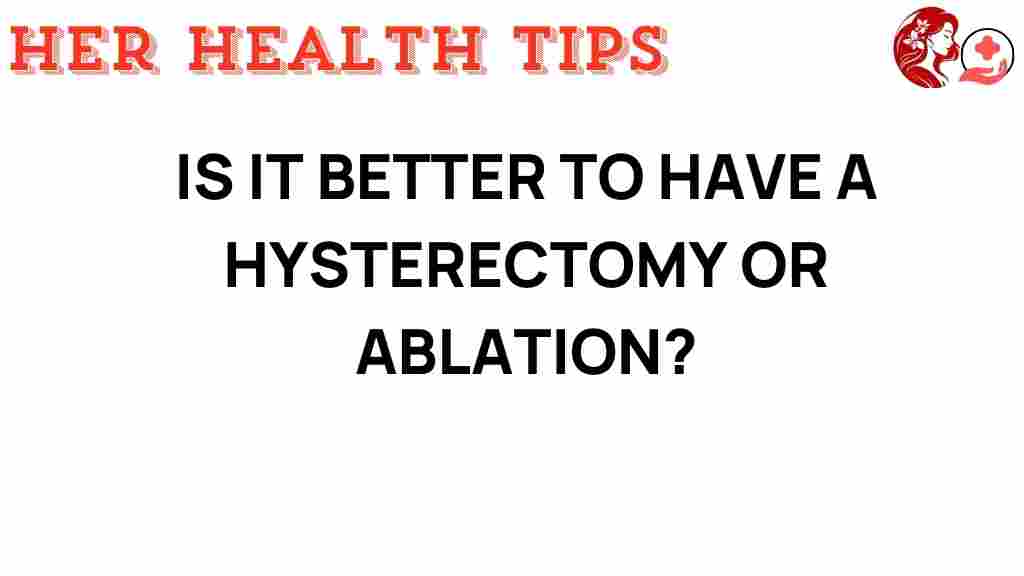Hysterectomy vs. Ablation: Which Option is Right for You?
When it comes to women’s health, the decision between a hysterectomy and endometrial ablation can be challenging. Both of these medical choices are options for treating various reproductive health issues, but they come with different implications for recovery, risks, and benefits. This article will explore both treatment options in detail, helping you make an informed decision about which option is right for you.
Understanding the Procedures
Before diving into the comparisons, it’s essential to understand what each procedure entails.
What is a Hysterectomy?
A hysterectomy is a surgical procedure that involves the removal of the uterus. It can be performed for various reasons, including:
- Uterine fibroids
- Endometriosis
- Uterine prolapse
- Chronic pelvic pain
- Cancer of the uterus, cervix, or ovaries
There are several types of hysterectomies:
- Total Hysterectomy: Removal of the uterus and cervix.
- Partial Hysterectomy: Removal of the uterus while leaving the cervix intact.
- Radical Hysterectomy: Removal of the uterus, cervix, surrounding tissue, and often part of the vagina.
What is Ablation?
Ablation, specifically endometrial ablation, is a minimally invasive procedure that destroys the lining of the uterus (the endometrium). It is primarily used to treat heavy menstrual bleeding (menorrhagia). Methods of ablation include:
- Thermal ablation
- Cryoablation (freezing)
- Radiofrequency ablation
- Hysteroscopic ablation
Unlike a hysterectomy, ablation does not involve the removal of the uterus.
Comparing Hysterectomy and Ablation
Indications for Each Procedure
Choosing between a hysterectomy and ablation often depends on the specific medical conditions present.
- Hysterectomy: Recommended for severe conditions such as fibroids or cancer where the uterus needs to be removed.
- Ablation: Suitable for women with heavy bleeding who wish to preserve their uterus and do not have significant underlying issues.
Recovery Times
Recovery varies significantly between the two procedures:
- Hysterectomy: Recovery can take 6 to 8 weeks, with restrictions on physical activity during this period.
- Ablation: Most women can return to normal activities within a few days to a week, making it a quicker recovery option.
Risks Associated with Each Procedure
Every surgical procedure carries risks. Here are some associated with both hysterectomy and ablation:
- Hysterectomy Risks:
- Infection
- Blood loss
- Damage to surrounding organs
- Emotional effects due to loss of reproductive organs
- Ablation Risks:
- Incomplete procedure leading to persistent bleeding
- Infection
- Scar tissue formation
- Potential need for future procedures
Benefits of Each Procedure
Understanding the benefits can help you in making your medical choices:
- Benefits of Hysterectomy:
- Eliminates the source of many reproductive health issues.
- Provides a definitive solution for conditions like cancer or fibroids.
- Long-term relief from symptoms.
- Benefits of Ablation:
- Less invasive with quicker recovery.
- Preserves the uterus, allowing for future pregnancies (if not contraindicated).
- Lower risk of major complications compared to hysterectomy.
Step-by-Step Decision Process
Deciding between a hysterectomy and ablation can be a daunting task. Follow these steps to make a more informed choice:
1. Consult with Your Healthcare Provider
Your first step should always be a thorough consultation with your healthcare provider. Discuss your symptoms, medical history, and the potential benefits and risks of each treatment option.
2. Understand Your Diagnosis
Having a clear understanding of your diagnosis is crucial. Conditions like fibroids, endometriosis, and abnormal bleeding require different treatment approaches.
3. Consider Your Future Plans
If you are considering future pregnancies, ablation may be a better choice, as hysterectomy eliminates the possibility of pregnancy entirely.
4. Evaluate Your Lifestyle and Preferences
Consider your lifestyle and how each procedure may affect it. If a quick recovery is important to you, ablation might be preferable.
5. Weigh the Risks and Benefits
Make a list of the risks and benefits of each procedure. Discuss these with your healthcare provider to gain clarity.
6. Get a Second Opinion
If you’re still unsure, consider seeking a second opinion from another healthcare professional to explore all options and perspectives.
Troubleshooting Common Concerns
As you navigate this decision-making process, you may encounter some common concerns:
1. Emotional Impact
Many women experience anxiety over the potential loss of their uterus. Consider speaking with a counselor or joining a support group to discuss these feelings.
2. Long-Term Health Effects
Research the long-term effects of both procedures, including hormonal changes post-hysterectomy, which can affect overall health.
3. Financial Considerations
Evaluate the cost of each procedure, including insurance coverage. Ablation may be less costly overall due to shorter recovery times and fewer complications.
Conclusion
Choosing between a hysterectomy and ablation is a significant decision that can impact your reproductive health and overall well-being. By understanding the differences, benefits, risks, and recovery times associated with each option, you can make a more informed choice that aligns with your health needs and personal circumstances.
It’s essential to consult with your healthcare provider to discuss your specific situation. Remember, your health is paramount, and making an informed decision is crucial for your long-term wellness.
For further reading on women’s health and treatment options, consider visiting womenshealth.gov.
For more information on reproductive health choices, check this internal link: Reproductive Health Decisions.
This article is in the category Reproductive and created by HerHealthTips Team
